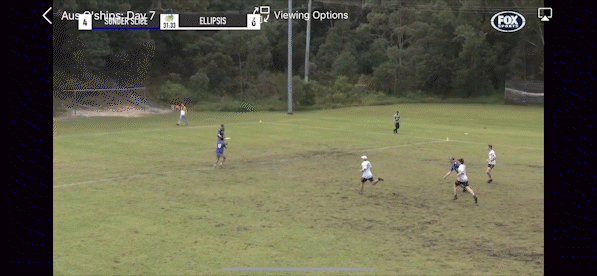Give goes are a cheat code in ultimate. When you throw the disc you should be immediately running off the mark. Even when you’re tired. Especially when you’re tired.
Why
Cutting is a difficult skill. Except for the top players in the game, a lot of people struggle with consistently getting open. Good defenders constantly adjust their positioning to take away the space you want to cut to. But imagine if every time someone defended you, they had to start right next to you, and could only move after you’d already taken your first step.
That’s what a give and go is.
Defenders on the mark are always trying to prevent you from throwing, not running. Given you’re the one throwing the disc, you’ll know when you can start running again while the marker is still thinking about stopping your throw. Being a step ahead in a cut has a snowball effect on the rest of the point:
You’re a step ahead, which means you can get to any space in that direction before your defender.
If your defender sells out trying to stop you getting to that space, you can change direction and beat them the other way.
Since your defender has to work double time to catch up, they’re going to be more tired and less in control than you for the rest of the point.
If the other team tries to contain you by switching, someone else will immediately be free without having to do any work for it.
Getting open gets a lot harder when you’re tired — when defending you upfield, your guarder can stand in a space that you want to get to, and that’s often enough to deter you from wanting to cut there. Their advantage increases, since you’ve gotten slower and don’t want to expend any more energy and mental power to beat them.
Give goes automatically switch the advantage in your favour. You don’t have to waste your dwindling mental power on thinking about how to beat your defender. Just start running, and their tired legs will give up on stopping you. This also alleviates the burden on the rest of your team, since it encourages defenders to switch and means less people need to get open from static positions.
What
When I talk about give goes I’m explicitly talking about the act of cutting immediately after you release the disc. To be clear, I’m not saying you need to get the disc back from the person you threw to. The give go can turn into a deep cut, a break side clear, an under, an up the line – literally any cut.
How
The how isn’t too difficult. It can be done on both forehands and backhands, with practice. The following video is a good illustration of both from my team in this year’s nationals final. The backhand give go often continues in the direction of the throw, while the forehand is the opposite - but there’s a variety of ways to execute and really: whatever works is good.
Here you can see how useful it becomes during a long point. Everyone (including me) is gassed from a lot of running. A well executed give go means we get a free endzone cut without requiring any cut set up or 1v1s, both of which take time and energy.
Here you can see how constant give goes allow me to consistently get easy dump resets. If the defender doesn’t commit to the upfield cut, I can either cut deep or jag and go upline. By moving immediately after the throw, I force them to make a quick decision on what they want to stop, and from there I have a 1-2 step advantage.
A final caveat
Sometimes less is more. Our structure last year was deliberately free-flowing and dynamic so give goes were especially powerful, but this isn’t always the case. There are structures, and a lot of circumstances, where you may need to keep the throwing lane clear, or need to stay in the dump space to provide a reset option. It’s also not something you can start doing in the nationals final without a season of training—give goes are a skill, a trainable movement, that rely on team chemistry to be effective.
The only way to get better is to start experimenting. Remember, a give go doesn’t necessarily mean that you get the disc straight back—at your next training, or league game, try throwing the disc and immediately taking off, and see where you end up.





